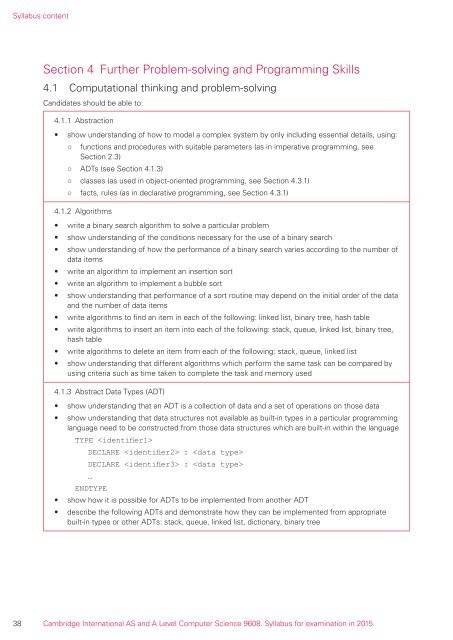129761-2015-syllabus
129761-2015-syllabus
129761-2015-syllabus
Create successful ePaper yourself
Turn your PDF publications into a flip-book with our unique Google optimized e-Paper software.
Syllabus content<br />
Section 4 Further Problem-solving and Programming Skills<br />
4.1 Computational thinking and problem-solving<br />
Candidates should be able to:<br />
4.1.1 Abstraction<br />
• show understanding of how to model a complex system by only including essential details, using:<br />
○<br />
functions and procedures with suitable parameters (as in imperative programming, see<br />
Section 2.3)<br />
○ ADTs (see Section 4.1.3)<br />
○ classes (as used in object-oriented programming, see Section 4.3.1)<br />
○ facts, rules (as in declarative programming, see Section 4.3.1)<br />
4.1.2 Algorithms<br />
• write a binary search algorithm to solve a particular problem<br />
• show understanding of the conditions necessary for the use of a binary search<br />
• show understanding of how the performance of a binary search varies according to the number of<br />
data items<br />
• write an algorithm to implement an insertion sort<br />
• write an algorithm to implement a bubble sort<br />
• show understanding that performance of a sort routine may depend on the initial order of the data<br />
and the number of data items<br />
• write algorithms to find an item in each of the following: linked list, binary tree, hash table<br />
• write algorithms to insert an item into each of the following: stack, queue, linked list, binary tree,<br />
hash table<br />
• write algorithms to delete an item from each of the following: stack, queue, linked list<br />
• show understanding that different algorithms which perform the same task can be compared by<br />
using criteria such as time taken to complete the task and memory used<br />
4.1.3 Abstract Data Types (ADT)<br />
• show understanding that an ADT is a collection of data and a set of operations on those data<br />
• show understanding that data structures not available as built-in types in a particular programming<br />
language need to be constructed from those data structures which are built-in within the language<br />
TYPE <br />
DECLARE : <br />
DECLARE : <br />
…<br />
ENDTYPE<br />
• show how it is possible for ADTs to be implemented from another ADT<br />
• describe the following ADTs and demonstrate how they can be implemented from appropriate<br />
built-in types or other ADTs: stack, queue, linked list, dictionary, binary tree<br />
38 Cambridge International AS and A Level Computer Science 9608. Syllabus for examination in <strong>2015</strong>.


